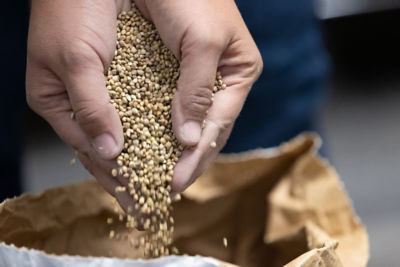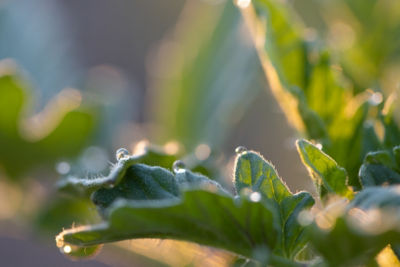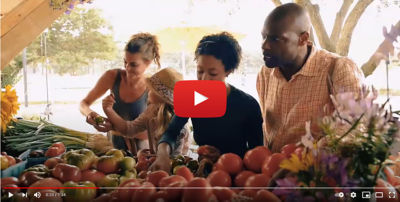Click here to download a PDF version of this spotlight.
» Yellow and purple nutsedge are important weed pests in vegetable production.
» These perennial plants survive in the soil as tubers for several years.
» An integrated program of cultural, mechanical, and chemical strategies is needed to manage nutsedge in vegetable systems.
Nutsedges are perennial plants and aggressive weeds that are difficult to manage. Nutsedges compete with crop plants for moisture, nutrients, and light, and can serve as alternate hosts for some crop pathogens.1,2,3 4 Both yellow nutsedge (Cyperus esculentus) and purple nutsedge (C. rotundus) are common in the U.S. Yellow nutsedge is found in vegetable production regions throughout the U.S. Purple nutsedge is primarily a problem in the southeastern and southwestern regions of the country. However, it does occur in some northern states.3,5,6
IDENTIFICATION
Nutsedges, also called nutgrass, look somewhat grass-like. However, they do not belong to the grass family. Sedges have thick leaves in sets of three and solid stems that are triangular in cross-section (sedges have edges), while grasses have round, hollow stems. Nutsedges have three bracts (leaf-like structures) at the base of the flower head and typically form tubers (sometimes called nuts or nutlets) on rhizomes in the soil. Tubers serve as survival and dispersal structures.3
Yellow nutsedge has bright-green leaves that gradually taper to a sharp tip. The flower heads and seeds are light brown (Figure 1A). The tubers are spherical, smooth, brown, and up to one-half inch in diameter. Tubers form singly at the ends of rhizomes (Figure 1B) and have a sweet flavor.1,2,3,7,8
 Figure 1. (A) The foliage of yellow nutsedge is bright green, and the flower heads are golden-yellow to light-brown. Howard F. Schwartz, Colorado State University, Bugwood.org. (B) Yellow nutsedge tubers are formed singly at the ends of rhizomes. Steve Dewey, Utah State University, Bugwood.org.
Figure 1. (A) The foliage of yellow nutsedge is bright green, and the flower heads are golden-yellow to light-brown. Howard F. Schwartz, Colorado State University, Bugwood.org. (B) Yellow nutsedge tubers are formed singly at the ends of rhizomes. Steve Dewey, Utah State University, Bugwood.org.
Purple nutsedge plants are smaller with dark green leaves that abruptly taper to a sharp tip. The flower heads are reddish, and the seeds are dark brown to black (Figure 2). Tubers are scaly, coarse, oblong, and reddish brown. They are up to one inch in diameter, form in chains, and have a bitter flavor.1,3,8
 Figure 2. The foliage of purple nutsedge is dark green, and the flower heads are are reddish with darkly colored seeds. Charles T. Bryson, USDA Agricultural Research Service, Bugwood.org.
Figure 2. The foliage of purple nutsedge is dark green, and the flower heads are are reddish with darkly colored seeds. Charles T. Bryson, USDA Agricultural Research Service, Bugwood.org.
LIFE CYCLE
Nutsedges are perennial plants that survive as tubers and rhizomes in the soil. Their leaves and flower stems die back at the end of the season. The tubers can remain viable in the soil for several years and can be found as deep as 18 inches below the soil surface. Tubers are spread within the field by cultivation, moving water, and other forms of soil movement. Long-distance dispersal can occur with soil on equipment, in infested compost or topsoil, and on infested nursery stock.3,4,7
Yellow nutsedge plants can produce hundreds to thousands of tubers in a season. Most tubers are distributed in the upper six inches of the soil. Tubers up to eight inches deep can sprout and emerge, and an individual tuber can sprout as many as seven times before exhausting its reserves. Tuber sprouting is affected by soil temperature and moisture conditions. Tubers (and rhizomes) begin to sprout when soil temperatures rise above 43°F for yellow nutsedge and above 59°F for purple nutsedge. Tubers tend to have a staggered emergence, with not all tubers emerging simultaneously. Emerging nutsedge stems are strong enough to penetrate and emerge through plastic mulches and landscape cloth.1,3,4,5,7
Nutsedges thrive in waterlogged soils and become established most easily in areas with poor drainage, leaky irrigation systems, or over-irrigated areas. Once established, nutsedge plants can tolerate drier soil conditions. While nutsedge plants produce seeds, seed viability is usually fairly low, and nutsedge seeds do not contribute much to plant dispersal.3,7,9
MANAGEMENT
Nutsedges are difficult to control, and no single measure will eliminate these weeds. The first priority should be to prevent nutsedge establishment in non-infested fields. Tillage and harvesting equipment should be cleaned of soil and plant debris before entering non-infested fields. Hay, straw, manure, and compost applied to the field should be obtained from reputable sources and free of nutsedge tubers and rhizomes.3,4,5 Improve soil drainage, and eliminate other factors causing wet soil conditions.3,9 Spot treat any nutsedge patches as soon as they appear to help prevent establishment. Avoid cultivating areas where nutsedge has emerged to limit the spread within the field.5
In fields where nutsedge has become established, multiple control strategies will be needed for long-term management, including cultural, mechanical, and chemical techniques.5,9
Cultural: Nutsedges are not shade tolerant, and promoting the rapid formation of dense crop canopies can help limit nutsedge development. Plant canopies 18 inches or taller usually provide enough shade to inhibit nutsedge growth.1,3,4 Select varieties that are well adapted to the region and growing conditions. Plant early using narrow row spacings and high plant populations. Manage disease, insect, and weed problems to maintain a full, healthy canopy.5 Apply levels of nitrogen fertilizer that promote optimal crop growth. The added nitrogen will not stimulate nutsedge growth.4,5
Rotating to corn and soybean crops that provide abundant shade can help manage nutsedge problems. Rotating to these crops can also allow the use of herbicides that are effective against nutsedge but may not be registered for use on vegetable crops.2 Rye cover crops also have some allelopathic effects against nutsedge and provide adequate soil shading.2,4
Mechanical: Tillage can be used to help manage nutsedge, but the timing is critical. Disking, chisel plowing, and moldboard plowing shortly after nutsedge seedlings have emerged can help destroy germinating tubers and kill young plants. However, this must be done before the plants start producing new tubers. Otherwise, tillage will spread the tubers and increase the area of infestation.3,4,5 Cultivation should be done before nutsedges reach the five to six-leaf stage. Tubers can regerminate, but they consume resources each time they do. Repeated cultivation, every two to three weeks, can reduce tuber viability over time. Nutsedge plants can be pulled up or hoed by hand, and the rhizomes and tubers can be dug up. However, the soil needs to be dug down to at least ten inches and then sifted to remove the rhizomes and tubers.3,9
Soils can be cultivated in mid-summer when it is warm and dry, so that tubers brought to the surface will dry out and lose viability over ten to twelve days. Repeated cultivation to bring additional tubers to the surface can help reduce the number of viable tubers by about 80% over a month.4,7
Chemical: The application of herbicides can also help manage nutsedge, and herbicides are most effective when used with other control methods. Few herbicides are available to selectively control nutsedge, especially for vegetable crops.1,3 Many of the herbicides available to selectively control grasses are not effective on nutsedge. Managing annual weeds with herbicides can actually increase problems with nutsedge because of reduced competition for resources.5,9
Several herbicides are registered for controlling nutsedge in corn and soybeans. These include products used for pre-plant incorporated (PPI), pre-emergence (PRE), and post-emergence applications. In corn, soil-applied herbicides often provided better control of nutsedge than foliar-applied products, and PPI applications are typically more effective than surface applications.5 Foliar treatments should be applied when nutsedge plants are actively growing but before they start to flower. Post-emergence products are often used as spot treatments to manage nutsedge plants missed by the soil treatments. Consult regional production and pest management guides for up-to-date recommendations on herbicides registered for controlling nutsedge on specific crops. Follow all label directions for rates, timing, restrictions and other application instructions.
Glyphosate can be used as a non-selective post-emergent herbicide for both purple and yellow nutsedge. It is best to apply the product in the late vegetative to early flowering stages of nutsedge growth before tubers have fully formed. Glyphosate can be translocated from the leaves to the tubers if the tubers are still attached to viable rhizomes. In later stages of growth, the rhizomes become inactive, preventing translocation to the tubers. Repeated applications will likely be needed to achieve adequate levels of control.1,5,7,9
Soil fumigation under plastic mulch can also help control yellow and purple nutsedge. Some soil fumigants, such as chloropicrin and metam sodium, used for pathogen and nematode control, can also suppress nutsedge when applied prior to or during mulch application.10
SOURCES
1 Kemble, J. 2004. Nutsedge control in commercial vegetables. Alabama Cooperative Extension System. ANR-1073.
2 Guldin, J. 2022. Yellow nutsedge. Rutgers Cooperative Extension Service.
https://burlington.njaes.rutgers.edu/2022/04/28/yellow-nutsedge/.
3 Wilen, C., McGiffen, M., and Elmore, C. 2010. Nutsedge. How to Manage Pests. UC IPM. UC ANR Publication 7432.
4 Melendez, M. and Besancon, T. 2022. Nutsedge life cycle disruptions for effective control. Rutgers Cooperative Extension Fact Sheet FS1341.
5 Lingenfelter, D., and Curran, W. 2017. Controlling yellow nutsedge in agronomic crops (an integrated approach). Penn State University.
6 Edd MapS. https://www.eddmaps.org/distribution/usstate.cfm?sub=5506.
7 DeFrank, J. 2013. Preplant control strategies for yellow nutsedge and other weeds in vegetable crops. Tropical Plant & Soil Sciences Department, University of Hawaii at Manoa.
8 Richards, D. 2013. Going nuts over nutsedge. Texas AgriLife A&M Extension.
9 Strickland, J. 2020. Nutsedge: a pesky weed in the garden & landscape. NC State Cooperative Extension.
10 Dittmar, P., Agehara, S., and Dufault, N. 2022. Vegetable Production Handbook of Florida 2022-2023. UF-IFSA.
Websites verified 4/5/2023
ADDITIONAL INFORMATION
For additional agronomic information, please contact your local seed representative.
Performance may vary from location to location and from year to year, as local growing, soil and weather conditions may vary. Growers should evaluate data from multiple locations and years whenever possible and should consider the impacts of these conditions on the grower’s fields. The recommendations in this article are based upon information obtained from the cited sources and should be used as a quick reference for information about vegetable production. The content of this article should not be substituted for the professional opinion of a producer, grower, agronomist, pathologist and similar professional dealing with vegetable crops.
BAYER GROUP DOES NOT WARRANT THE ACCURACY OF ANY INFORMATION OR TECHNICAL ADVICE PROVIDED HEREIN AND DISCLAIMS ALL LIABILITY FOR ANY CLAIM INVOLVING SUCH INFORMATION OR ADVICE.
5023_226800 Published 04/21/2023




